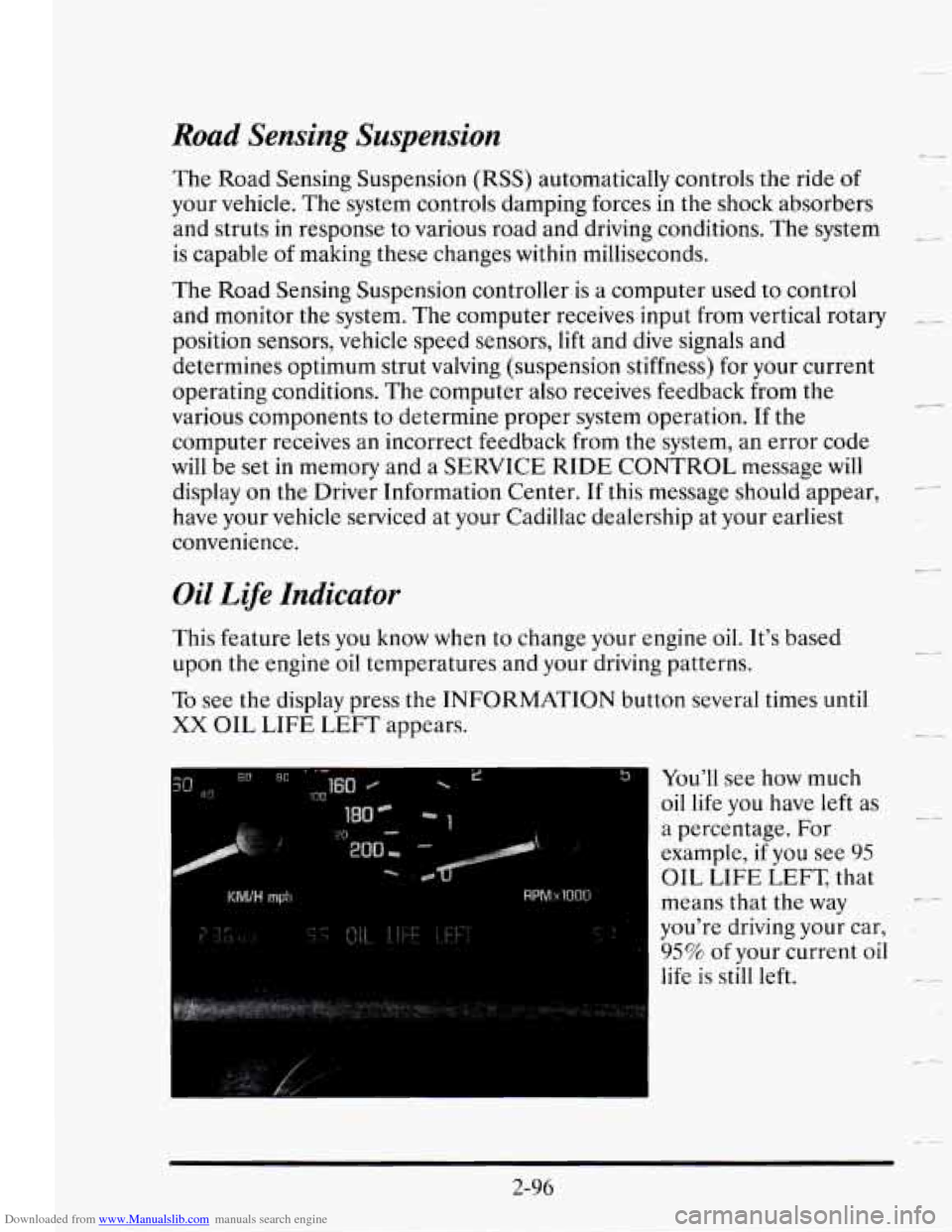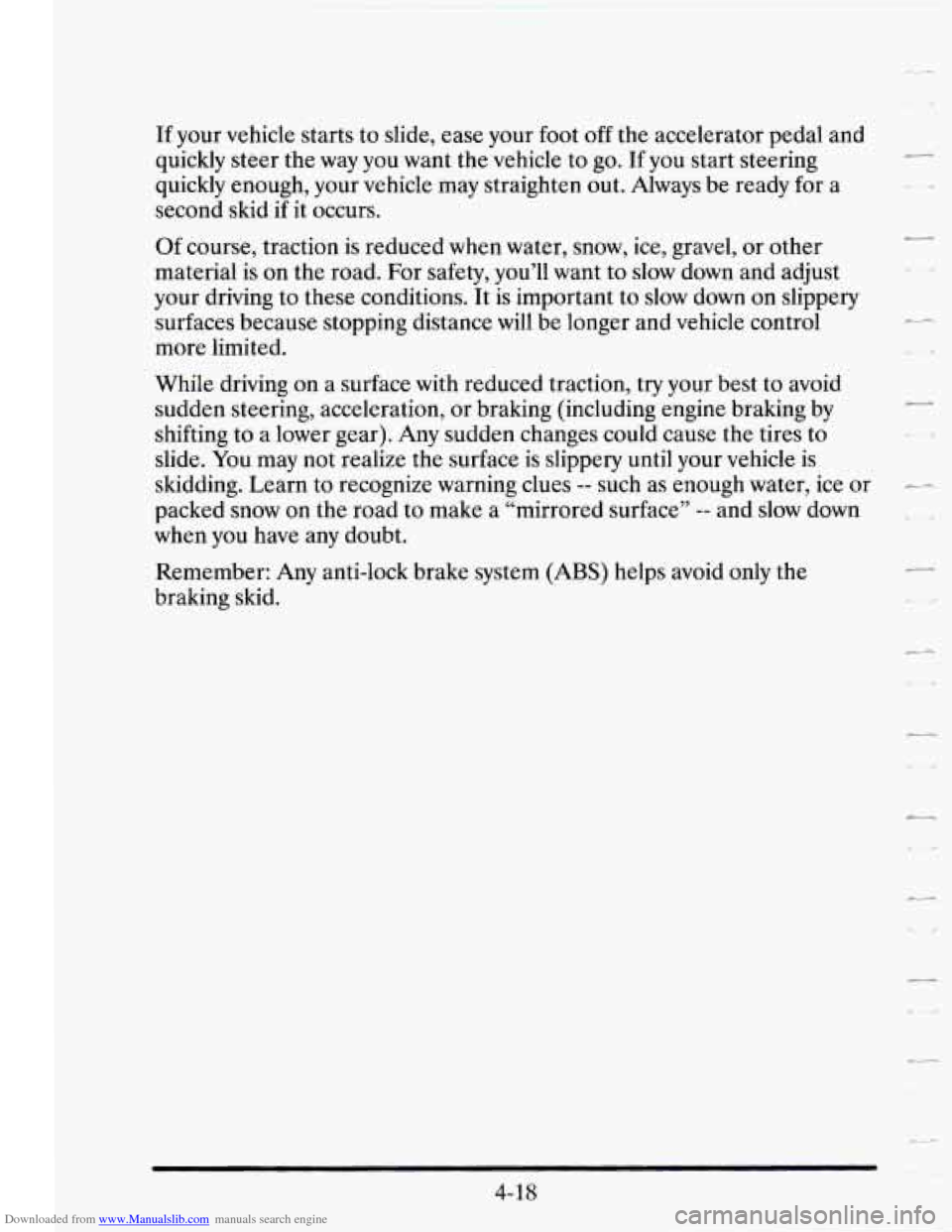Page 138 of 410
Downloaded from www.Manualslib.com manuals search engine COmNIENCE NET
r
r
You’ll find the
convenience net just
inside the back wall
of
the trunk.
Put small loads, like grocery bags, behind the net. It can help keep them
from falling over during sharp turns or quick starts and stops.
The net is not for larger, heavier loads. Store them in the trunk as far
forward as
you can. When not using the net, hook the net to the tabs
securing it to the sill plate.
FRONT SEAT VMITYMIIRRORS
To use one, turn the
sunshade down. Then
lift the cover up to see
the mirror. The slide
lamp intensitv.
I switch controls the
2-67
Page 151 of 410

Downloaded from www.Manualslib.com manuals search engine Anti-Lock Brake System Warning Light
ANTI-
LOCK (0 ABS)
With the anti-lock brake system, this light will come on when you start
your engine and may stay on
for several seconds. That’s normal. If the
light doesn’t come on, have it fixed
so it will be ready to warn you if there
is a problem.
If the light stays on, turn the ignition off. Or, if the light comes on when
you’re driving, stop as soon as possible and turn the ignition
off. Then
start the engine again to reset the system. If the light still stays
on, or
comes on again while you’re driving, your Cadillac needs service.
If the
regular brake system warning light isn’t on, you still have brakes, but you
don’t have anti-lock brakes.
If the regular brake system warning light is
also on, you don’t have anti-lock brakes and there’s
a problem with your
regular brakes.
See “Brake System Warning Light” earlier in this part.
Traction Disabled Message
If this message is displayed, there’s a problem with your traction control
system and your vehicle needs service. When this message is displayed,
the system will not limit wheel spin. Adjust your driving accordingly.
-,.
c-
2-80
Page 167 of 410

Downloaded from www.Manualslib.com manuals search engine Road Sensing Suspension
The Road Sensing Suspension (RSS) automatically controls the ride of
your vehicle. The system controls damping forces in the shock absorbers
and struts in response to various road and driving conditions. The system
- .-
is capable of making these changes within milliseconds.
The Road Sensing Suspension controller is a computer used to control
and monitor the system. The computer receives input from vertical rotary
I__
position sensors, vehicle speed sensors, lift and dive signals and
determines optimum strut valving (suspension stiffness) for your current
operating conditions. The computer also receives feedback from the
various components to determine proper system operation. If the
computer receives an incorrect feedback from the system, an error code
will be set in memory and a SERVICE RIDE CONTROL message will
display on the Driver Information Center. If this message should appear,
have your vehicle serviced at your Cadillac dealership at your earliest
convenience.
Oil Life Indicator
This feature lets you know when to change your engine oil. It's based
upon the engine oil temperatures and your driving patterns.
To see the display press the INFORMATION button several times until
XX OIL LIFE LEFT appears.
"I You'll see how much
oil life you
have left as
a percentage. For
example, if
you see 95 - ---
OIL LIFE LEFT, that
means that the way
c_
you're driving your car,
95% of your current oil
life is still left.
c-
2-96
Page 199 of 410
Downloaded from www.Manualslib.com manuals search engine Anti-Lock Brakes (ABS)
Your Cadillac has an advanced electronic braking system that will help
prevent a braking skid.
ANTI-
LOCK (0 ABS)
This light on the instrument panel will come on briefly when you start
your vehicle.
When you start your vehicle and begin to drive away, you may hear a
momentary motor or clicking noise.
And you may even notice that your
brake pedal moves a little while this is going on. This is the
ABS system
testing itself.
If there’s a problem with the anti-lock brake system, the
anti-lock brake system warning light will stay on.
See “Anti-Lock Brake System Warning Light” in the Index.
c-
-
c ..*
4-8
Page 200 of 410
Downloaded from www.Manualslib.com manuals search engine Here’s how anti-lock works. Let’s say the road is wet. You’re driving
safely. Suddenly an animal jumps out
in front of you.
You slam on the brakes. Here’s what happens with
ABS.
A computer senses that wheels are slowing down. If one of the wheels is
about to stop rolling, the computer
will separately work the brakes at each
front wheel and at the rear wheels.
The anti-lock system can change the brake pressure faster than any driver
could.
The computer is programmed to make the most of available tire
and road conditions.
Page 209 of 410

Downloaded from www.Manualslib.com manuals search engine If your vehicle starts to slide, ease your foot off the accelerator pedal and
quickly steer the way you want the vehicle
to go. If you start steering
quickly enough, your vehicle may straighten out. Always be ready for a
second skid
if it occurs.
Of course, traction is reduced when water, snow, ice, gravel, or other
material is on the road. For safety, you’ll want to
slow down and adjust
your driving to these conditions. It is important to slow down on slippery
surfaces because stopping distance will be longer and vehicle control
-
more limited.
r
While driving on a surface with reduced traction, try your best to avoid
sudden steering, acceleration, or braking (including engine braking by
shifting to a lower gear). Any sudden changes could cause the tires to
slide. You may not realize the surface is slippery until your vehicle is
skidding. Learn to recognize warning clues
-- such as enough water, ice or --
packed snow on the road to make a “mirrored surface” -- and slow down .
when you have any doubt.
Remember: Any anti-lock brake system
(ABS) helps avoid only the
braking skid.
4-18
c
Page 238 of 410

Downloaded from www.Manualslib.com manuals search engine Parking on Hills
You really should not park your vehicle, with a trailer attached, on a hill.
If something goes wrong, your rig could start to move. People can be
But
if you ever have to park your rig on a hill, here’s how to do it:
0 Apply your regular brakes, but do not shift into PARK (P).
0 Have someone place chocks under the trailer wheels.
0 When the wheel chocks are in place, release the regular brakes until
0 Reapply the regular brakes. Then shift into PARK (P) firmly and apply
Release the regular brakes.
__ injured, and both your vehicle and the trailer can be damaged.
the chocks absorb the load.
your parking brake.
When You Are Ready to Leave Afier Parking on a Hill
1. Apply your regular brakes and hold the pedal down while you:
Start your engine;
0 Shift into a gear; and
0 Be sure the parking brake has released.
2. Let up on the brake pedal.
3. Drive slowly until the trailer is clear of the chocks.
4. Stop and have someone pick up and store the chocks.
4-47
Page 290 of 410
Downloaded from www.Manualslib.com manuals search engine Push the two tabs and
pivot the top half to
separate the air
cleaner.
Once you have
replaced
the air cleaner
filter, reverse the steps
to reassemble.
AUTOMATIC TRANSAXLE FLUID
when to Check and Change
A good time to check your automatic transaxle fluid level is when the
engine oil is changed. Refer to the Maintenance Schedule to determine
when
to change your fluid.
6-19